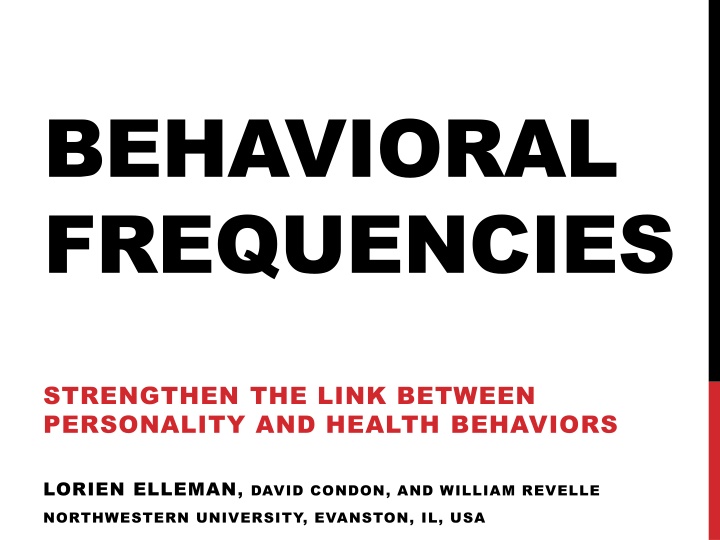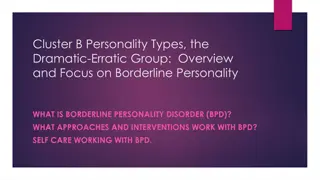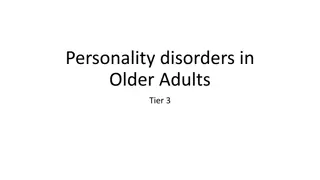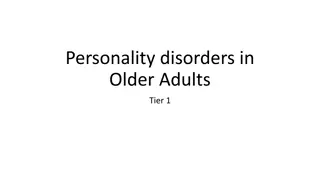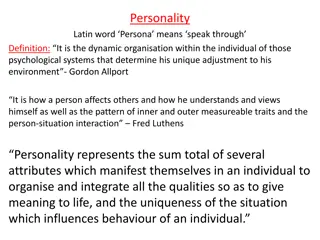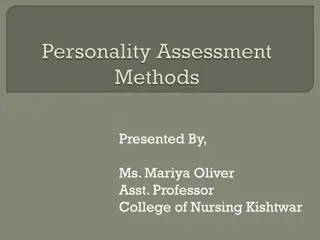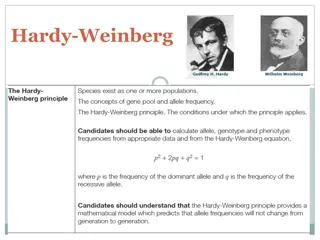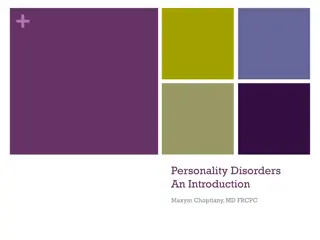Behavioral Frequencies and Personality Traits: Strengthening the Health Behavior Connection
Personality traits and behaviors play a crucial role in shaping health outcomes. Understanding how behavioral frequencies influence the link between personality and health behaviors can provide valuable insights for improving overall well-being. Traditional trait explanations may not always capture the full picture, and exploring predictive models alongside behavioral patterns can enhance our understanding of this complex relationship. Leveraging approaches like the Best Items approach and standard k-folds cross-validation can further refine the analysis and offer more accurate predictions.
Download Presentation

Please find below an Image/Link to download the presentation.
The content on the website is provided AS IS for your information and personal use only. It may not be sold, licensed, or shared on other websites without obtaining consent from the author.If you encounter any issues during the download, it is possible that the publisher has removed the file from their server.
You are allowed to download the files provided on this website for personal or commercial use, subject to the condition that they are used lawfully. All files are the property of their respective owners.
The content on the website is provided AS IS for your information and personal use only. It may not be sold, licensed, or shared on other websites without obtaining consent from the author.
E N D
Presentation Transcript
BEHAVIORAL FREQUENCIES STRENGTHEN THE LINK BETWEEN PERSONALITY AND HEALTH BEHAVIORS LORIEN ELLEMAN, DAVID CONDON, AND WILLIAM REVELLE NORTHWESTERN UNIVERSITY, EVANSTON, IL, USA
PERSONALITY = PATTERNS Personality refers to individual differences in characteristic patterns of thinking, feeling, and behaving (American Psychological Association, 2018). Personality doesn t have to be just broad traits. Personality could be narrow patterns of thinking and feeling (e.g., I feel that I m unable to deal with things. ) or behaving (e.g., I eat while driving. )
SATISFYING EXPLANATIONS Traditional trait explanations are more satisfying and appear to be less circular or obvious than behavioral patterns. Example: Neuroticism and BMI are positively correlated (Sutin et al., 2011), therefore a neurotic (or impulsive) personality causes a higher BMI. That s a satisfying explanation! But it s wrong. This apparent trait-level relationship was due to just two items: I tend to eat too much. I sometimes eat myself sick (Terracciano et al., 2009).
PREDICTION VS. EXPLANATION The Act Frequency approach Dispositions are viewed as summaries of act frequencies that, in themselves, possess no explanatory status (Buss & Craik, 1983). Machine learning / statistical learning theory research programs that emphasize prediction, and that treat explanation as a secondary goal, would be more fruitful both in the short term and the long term (Yarkoni & Westfall, 2017). Behavioral frequencies + machine learning = good prediction but no explanation?
THE BEST ITEMS APPROACH: BETTER PREDICTION WITH SOME EXPLANATION The Best Items approach simply finds the top items in an item pool that most highly correlate with a criterion (utilizing k-folds cross-validation).
STANDARD K-FOLDS CROSS-VALIDATION A data set is randomly divided into X (e.g., 10) parts, or folds. For each iteration, correlations are found between the outcome variable of interest (e.g., BMI) and each personality item, excluding the data from the cross- validation fold. These correlations are cross-validated using the cross-validation fold. Modified from Dhindsa (2017)
BEST ITEMS K-FOLDS CROSS-VALIDATION For each iteration, only the correlations with the outcome and the top Y (e.g., 15) items are cross- validated. Average item-level correlations are found across iterations, and the items that were consistently the best items are kept. Modified from Dhindsa (2017)
THE BEST ITEMS APPROACH: BETTER PREDICTION WITH SOME EXPLANATION Prediction is improved by selecting items with the largest correlations across scales. Item content can reveal possible explanations (e.g., overeating, lack of exercise, sedentary lifestyle).
OUR PREVIOUS STUDY (ELLEMAN, CONDON & REVELLE, 2017) Hypothesis: Behavioral frequencies would better predict four behavioral criteria than traditional personality items. Patterns of behaviors would predict patterns of behaviors. Traditional personality items wouldn t measure patterns of behaviors as well as behavioral frequencies. Example: I feel that I m unable to deal with things, versus I eat while driving.
OUR PREVIOUS STUDY (ELLEMAN, CONDON & REVELLE, 2017) N 31,000 (51% female) from 166 countries Our pool of 299 personality items: 199 behavioral frequencies (ORAIS; frequency of behavior in the past year) 100 Big Five personality items (IPIP-BFFM; Likert-type scale) We found the 10 best items for each of four criteria. Exercise frequency Body Mass Index (BMI) Smoking frequency Relationship status There was only 1 Big Five item in the total top 40.
OUR CURRENT STUDY Part of the SAPA project (sapa-project.org) Online personality assessment Data collected February 2017 May 2018 N = 177,853 (65% female) Median age: 21 years (MAD = 5.9; range = 14 - 90) From 226 countries 22% from the U.S. 16% from India 7% from the Phillippines 4% from Pakistan Diversity within the U.S.: 32% non-white
OUR CURRENT STUDY We found the 10 best items for each of 12 health variables of interest: General health Body Mass Index (BMI) Exercise frequency Smoking frequency Emergency Room visits Sleep quality Average hours slept Prescription adherence Caffeine consumption Overall stress Brush teeth frequency Floss teeth frequency
OUR CURRENT STUDY Our pool of 1,150 personality items: 454 behavioral frequencies (ORAIS + 255 items from Hirsh & DeYoung, 2009) 696 traditional personality items (IPIP; Condon & Revelle, 2015) Each participant received a random sample of these items. Massively Missing Completely at Random (MMCAR) data In our previous study, there was 1 traditional personality item in the 40 total best items (10 best items * 4 criteria). In this study, there were 79 traditional personality items in the 120 total best items (10 best items * 12 criteria). In general, each criterion was predicted by only one item type. Behavioral items predicted behaviors / quantities. Traditional personality items predicted feelings / internal states.
10 BEST ITEMS FOR FREQUENCY OF CIGARETTE SMOKING
ITEM TYPE BY WHICH CRITERIA WERE PREDICTED Traditional personality items ///////////////////////////// /////////////////////////// Both ______________ ___ /////////////////////////////////// /////////////////////////////Be havioral items _________________ ____ ///////////////////////////// /////////////////////Over all stress Exercise Smoking frequency General health Caffeine consumption Sleep quality Body Mass Index Prescription adherence
MULTIPLE CORRELATIONS OF 10 BEST ITEMS AND PREDICTED CRITERION
CONCLUSIONS / REMARKS Many health behaviors/outcomes are related to personality (i.e., patterns of thoughts, feelings, and behaviors). However, some health behaviors/outcomes may be more related to behavioral frequencies than traditional personality items. For example, BMI may not be related to a Big Five trait or lower- level facet, but instead it may be related to patterns of behavior that are unique from the Big Five / traditional traits. Behavioral frequencies (and Best Items ) can provide both prediction and explanation of personality-criterion relationships. It may be especially helpful to use behavioral frequencies as predictors of criteria that are more behavioral or quantifiable.
ACKNOWLEDGEMENTS Thank you: Sarah McDougald This analysis used the development version of the psych package in R (version 1.8.6; Revelle, 2018), which can be installed using the command: install.packages("psych", repos="http://personality-project.org/r", type="source ) These slides will be available at: https://sapa-project.org/lge/ Email: lgelleman@u.northwestern.edu
APPENDIX: WE REMOVED ITEMS THAT WERE TOO SIMILAR TO THE VARIABLE BEING PREDICTED. General health: 1 traditional personality item ( Feel healthy and vibrant most of the time. ) BMI: 1 behavior ( Gained at least 10 pounds (5 kg) in body weight. ) Exercise frequency: 14 behaviors Smoking frequency: 3 behaviors Emergency Room visits: 2 behaviors Sleep quality: 1 traditional, 3 behaviors Average hours slept: 1 traditional, 5 behaviors Prescription adherence: 0 items Caffeine consumption: 3 behaviors Overall stress: 2 traditional personality items Brush teeth frequency: 0 items Floss teeth frequency: 0 items
APPENDIX: ACCOUNTING FOR MULTIPLE COMPARISONS There were 1,150 personality items and 12 predicted criterion. 1,150 * 12 = 13,800 multiple comparisons. Bonferroni correction: p * 13,800 You d need: p < 3.6 * 10-6 (instead of p < 5 * 10-2) For n = 1,400, you d need: |r| > .20
